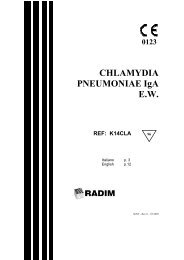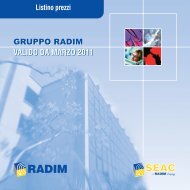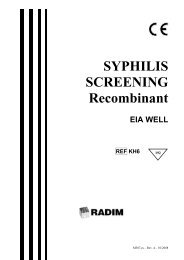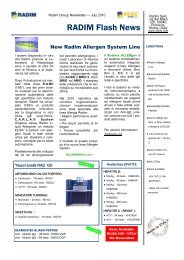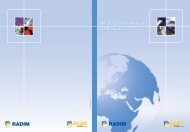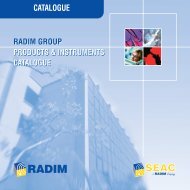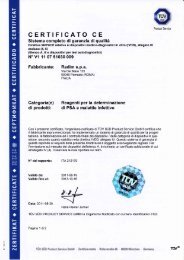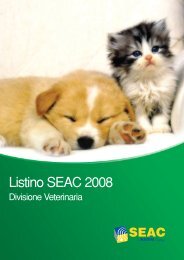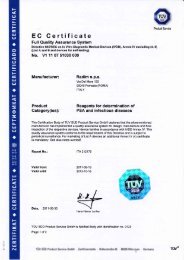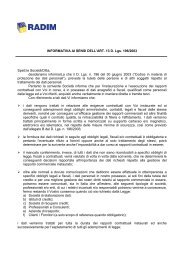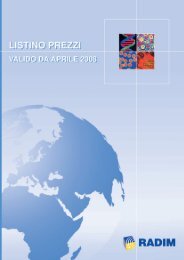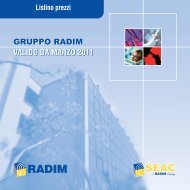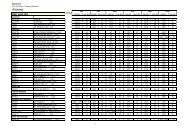GLIADINA IgG EIA WELL REF - Radim S.p.A.
GLIADINA IgG EIA WELL REF - Radim S.p.A.
GLIADINA IgG EIA WELL REF - Radim S.p.A.
Create successful ePaper yourself
Turn your PDF publications into a flip-book with our unique Google optimized e-Paper software.
<strong>GLIADINA</strong> <strong>IgG</strong><br />
<strong>REF</strong> K9GG<br />
<strong>EIA</strong> <strong>WELL</strong><br />
96<br />
Italiano p. 3<br />
English p. 12<br />
M130 – Rev.9 – 05/2008 – Pag. 1/24
REAGENTI DEL KIT - KIT REAGENTS<br />
Reag. Quant<br />
MTP<br />
WASH<br />
DIL<br />
CAL<br />
CONJ<br />
TMB<br />
STOP<br />
1 x 96 Pronti per l'uso,<br />
Ready for use<br />
1 x 50 mL Conc<br />
1 x 20 mL Conc<br />
2x (4 x 1 mL) Liof,<br />
Lyoph<br />
1 x 14 mL Pronto per l'uso<br />
Ready for use<br />
2 x 15 mL Pronto per l'uso<br />
Ready for use<br />
1 x 14 mL Pronto per l'uso<br />
Ready for use<br />
"Le Istruzioni per l'uso tradotte nelle altre lingue di interesse sono consultabili sul sito<br />
Internet all'indirizzo www.radim.com".<br />
“The instructions for use available in the other languages of interest can be viewed on our<br />
website www.radim.com".<br />
“Οι οδηγίες χρήσης μεταφρασμένες στις άλλες ενδιαφερόμενες γλώσσες όπως επίσης στην<br />
ηλεκτρονική διεύθυνση www.radim.com".<br />
“In den anderen Sprachen von Interesse ist die Bedienungsanleitung kann auf der Website<br />
unter der Adresse www.radim.com konsultiertwerden”.<br />
"Le mode d’emploi dans les autres langues intéressées est consultable sur le site Internet à<br />
l'adresse www.radim.com”.<br />
“Las instrucciones de uso traducidas en los otros idiomas de interés se pueden consultar en<br />
nuestro sitio Internet www.radim.com”.<br />
"As instruções de uso traduzidas nos outros idiomas de interesse podem ser consultadas<br />
no nosso site Internet, ao endereço www.radim.com."<br />
K9GG – <strong>GLIADINA</strong> <strong>IgG</strong> <strong>EIA</strong> <strong>WELL</strong><br />
M130 – Rev.9 – 05/2008 – Pag. 2/24
DOSAGGIO IMMUNOENZIMATICO PER LA DETERMINAZIONE<br />
QUANTITATIVA DEGLI ANTICORPI <strong>IgG</strong> ANTI-<strong>GLIADINA</strong> NEL SIERO O<br />
PLASMA UMANO.<br />
PER USO DIAGNOSTICO IN VITRO<br />
1. APPLICAZIONI CLINICHE<br />
Il glutine è una componente proteica della farina di grano e di altri cereali. In<br />
soggetti con intolleranza al glutine, in seguito all'ingestione di cereali, si instaura<br />
una enteropatia denominata malattia celiaca, caratterizzata da vari disturbi<br />
digestivi (malassorbimento intestinale, diarrea), da ritardo della crescita e a volte<br />
da dermatite erpetiforme.<br />
A livello anatomico, la malattia celiaca è accompagnata da atrofia dei villi della<br />
mucosa dell'intestino tenue, ipertrofia delle cripte ed ipercellularità della mucosa.<br />
La presenza di queste lesioni, rilevabili mediante biopsia dell'intestino tenue,<br />
consente di effettuare una diagnosi certa di malattia celiaca. Secondo il protocollo<br />
diagnostico proposto nel 1970 dell'European Society for Paediatric<br />
Gastroenterology and Nutrition (ESPGAN), si richiede, ai fini di una diagnosi<br />
definitiva, l'esecuzione di tre biopsie; prima e dopo l'eliminazione totale del glutine<br />
della dieta (per osservare la normalizzazione della mucosa intestinale) e dopo<br />
una nuova introduzione di glutine nella dieta (per osservare la ricomparsa delle<br />
lesioni caratteristiche). Una diagnosi preliminare di malattia celiaca può essere<br />
effettuata determinando quantitativamente la presenza nel siero del paziente di<br />
anticorpi di classe IgA e <strong>IgG</strong> diretti contro la Gliadina, una componente del glutine.<br />
Esiste infatti una forte associazione tra malattia celiaca e presenza di elevati titoli<br />
anticorpali di IgA e <strong>IgG</strong> anti-Gliadina; pertanto il dosaggio di questi anticorpi può<br />
essere utilizzato sia come depistage per indirizzare o meno il paziente<br />
all'esecuzione della biopsia, sia come follow-up per controllare, dopo remissione<br />
della malattia, il rispetto della dieta priva di glutine da parte del paziente.<br />
2. PRINCIPIO DEL METODO<br />
Il presente kit è basato sul metodo immunoenzimatico (ELISA) ed utilizza come<br />
marcatore enzimatico la perossidasi. Durante la prima incubazione, gli anticorpi<br />
anti-Gliadina della classe <strong>IgG</strong> eventualmente presenti nel siero in esame, si<br />
legano alla Gliadina adesa alla superficie dei pozzetti. Tramite lavaggio viene<br />
eliminato il materiale non legato; in una successiva incubazione gli anticorpi anti-<br />
<strong>IgG</strong> umane, coniugati alla perossidasi, reagiscono con il complesso<br />
precedentemente formatosi tra antigene ed anticorpo anti-Gliadina. Dopo ulteriore<br />
lavaggio, viene aggiunta tetrametilbenzidina (TMB) incolore che, reagendo con la<br />
perossidasi presente, produce un composto colorato. La reazione di sviluppo del<br />
colore è bloccata con l'aggiunta di H2SO4 e l'intensità del colore, misurata<br />
mediante spettrofotometro a 450 nm e a 405 nm, è direttamente proporzionale<br />
alla concentrazione di anticorpi <strong>IgG</strong> anti-Gliadina presenti nei calibratori e nei<br />
campioni in esame.<br />
3. REAGENTI CONTENUTI NEL KIT: PREPARAZIONE E STABILITA'<br />
K9GG – <strong>GLIADINA</strong> <strong>IgG</strong> <strong>EIA</strong> <strong>WELL</strong><br />
M130 – Rev.9 – 05/2008 – Pag. 3/24
− I reagenti sono sufficienti per 96 pozzetti.<br />
− Il kit deve essere conservato a 2-8°C.<br />
− La data di scadenza di ciascun reagente è indicata sulla rispettiva etichetta.<br />
− Una volta aperto il kit è stabile 2 mesi a 2-8°C.<br />
3.1 Reagenti Specifici<br />
• MTP Micropiastra Sensibilizzata: 1 micropiastra da 96 pozzetti, divisibili<br />
singolarmente, sensibilizzati con Gliadina. I pozzetti non utilizzati devono<br />
essere conservati a 2-8°C nella bustina di plastica trasparente fornita,<br />
sigillata accuratamente.<br />
• CAL Calibratori: 2 set ciascuno costituito da 4 flaconi contenenti <strong>IgG</strong> anti-<br />
Gliadina in matrice sierica, alle seguenti concentrazioni: 0, 50, 100 e 200<br />
UR/mL. Conservante: NaN3 (
− Micropipette automatiche a puntali intercambiabili a volume variabile.<br />
− Stufa termostatata a 37±2°C.<br />
− Cilindri graduati per la diluizione dei reattivi.<br />
− Pompa aspirante oppure apparecchiatura automatica per il lavaggio delle<br />
micropiastre.<br />
− Spettrofotometro di precisione per micropiastre, con possibilità di misura in<br />
assorbanza nell'intervallo 0-3.0 A ad una lunghezza d'onda di 450 e 405 nm.<br />
− Carta millimetrata.<br />
− H2O distillata.<br />
4.2 Dosaggio Automatico<br />
− Il dispositivo può essere utilizzato con strumentazione automatica di kit ELISA<br />
su micropiastra.<br />
− Si garantisce l’applicabilità su strumentazione RADIM e/o SEAC<br />
− Qualora si utilizzi strumentazione automatica di altri fornitori, è responsabilità<br />
dell’utilizzatore assicurarsi che il kit sia stato opportunamente validato.<br />
5. AVVERTENZE E PRECAUZIONI<br />
Per ottenere risultati corretti e riproducibili, è necessario osservare le<br />
seguenti norme:<br />
− Non mescolare i reagenti specifici (vedi 3.1) di lotti differenti.<br />
− E’ possibile utilizzare reagenti comuni (vedi 3.2) di lotti differenti.<br />
− Non usare i reagenti dopo la data di scadenza.<br />
− Non esporre i reattivi e i campioni a calore intenso o a forti sorgenti di<br />
inquinamento.<br />
− Usare vetreria perfettamente pulita ed esente da contaminazioni di ioni<br />
metallici o sostanze ossidanti.<br />
− Usare acqua distillata o deionizzata, conservata in recipienti perfettamente<br />
puliti.<br />
− Evitare accuratamente contaminazioni tra campioni; a tal fine è consigliabile<br />
usare pipette con puntali monouso per ogni campione e per ogni reattivo.<br />
− Non modificare in alcun modo il Procedimento Operativo di esecuzione del<br />
test. Eventuale non rispetto di:<br />
• sequenza e quantità nell’aggiunta dei reattivi<br />
• tempi e temperatura di incubazione<br />
può dare luogo a risultati clinici errati.<br />
− Ricostituire gli eventuali reagenti liofili secondo le modalità descritte sulle<br />
etichette. Eventuale utilizzo di reattivi o volumi non idonei, può provocare<br />
l’ottenimento di dati clinici non attendibili.<br />
− In caso di procedura manuale è importante l’utilizzo di pipette calibrate e<br />
possedere un’adeguata manualità tecnica. In particolare è essenziale una<br />
K9GG – <strong>GLIADINA</strong> <strong>IgG</strong> <strong>EIA</strong> <strong>WELL</strong><br />
M130 – Rev.9 – 05/2008 – Pag. 5/24
uona precisione nella preparazione e dispensazione dei reattivi. E’<br />
necessario un adeguato piano di manutenzione (pulizia e calibrazione) di tale<br />
strumentazione.<br />
− Assicurarsi che la pompa di aspirazione oppure l’apparecchiatura automatica<br />
per il lavaggio delle micropiastre sia perfettamente funzionante. Un lavaggio<br />
non accurato delle micropiastre può dare luogo a misclassificazione dei<br />
campioni. E’ necessario un adeguato piano di manutenzione di tale<br />
strumentazione.<br />
− Assicurarsi che lo spettrofotometro per micropiastre sia perfettamente<br />
funzionante. L’utilizzo di uno spettrofotometro non calibrato o con filtri non<br />
puliti, può comportare un errore nella lettura dei campioni, con conseguente<br />
possibile misclassificazione degli stessi. E’ necessario un adeguato piano di<br />
manutenzione (pulizia e calibrazione) di tale strumentazione.<br />
− Assicurarsi che la stufa termostatata (se necessaria) sia perfettamente<br />
funzionante. L’incubazione a temperature diverse da 37±2°C può dare luogo a<br />
perdita di sensibilità e/o a denaturazione biologica dei materiali (reattivi e/o<br />
campioni). E’ necessario un adeguato piano di manutenzione di tale<br />
strumentazione e un controllo periodico della temperatura registrata.<br />
− Assicurarsi che l’agitatore per micropiastre (se necessario) sia perfettamente<br />
funzionante. L’agitazione in condizione diverse dall’atteso può dare luogo a<br />
misclassificazione dei campioni . E’ necessario un adeguato piano di<br />
manutenzione di tale strumentazione.<br />
− Assicurarsi che la strumentazione utilizzata per la conservazione dei campioni<br />
e/o del dispositivo sia perfettamente funzionante. La conservazione a<br />
temperature diverse dall’atteso, può dare luogo a denaturazione biologica dei<br />
materiali (reattivi e/o campioni). E’ necessario un adeguato piano di<br />
manutenzione di tale strumentazione e un controllo periodico della<br />
temperatura registrata.<br />
− Utilizzare un adeguato metodo per la corretta identificazione dei campioni.<br />
Possibili conseguenze possono essere sia la perdita di specificità del<br />
dispositivo che risultati analitici errati.<br />
Per evitare contaminazioni personali ed ambientali, è necessario osservare<br />
le seguenti norme di sicurezza:<br />
− Utilizzare guanti monouso durante la manipolazione di materiale<br />
potenzialmente infetto e durante il dosaggio.<br />
− Non pipettare i reagenti con la bocca.<br />
− Non fumare, mangiare, bere o applicare cosmetici durante l'esecuzione del<br />
dosaggio.<br />
− Le soluzioni di Cromogeno e Reagente Bloccante vanno manipolate con<br />
cautela. Evitare il contatto con la pelle, gli occhi e le mucose. In caso di<br />
incidente lavare abbondantemente con acqua.<br />
K9GG – <strong>GLIADINA</strong> <strong>IgG</strong> <strong>EIA</strong> <strong>WELL</strong><br />
M130 – Rev.9 – 05/2008 – Pag. 6/24
− I materiali di origine umana utilizzati nella preparazione del presente kit sono<br />
stati saggiati per la presenza di HBsAg, anti-HIV e anti-HCV e sono risultati<br />
ripetutamente negativi. Comunque nessun test attualmente disponibile<br />
garantisce l'assenza degli agenti virali responsabili della sindrome da<br />
immunodeficienza acquisita, dell'epatite B ed epatite C. Tutti i reagenti<br />
contenenti materiale biologico e tutti i campioni di siero umano devono essere<br />
considerati potenzialmente infettivi.<br />
− Evitare la produzione di schizzi e la formazione di aerosol; qualora ciò si<br />
verificasse ripulire accuratamente con ipoclorito di sodio ad una<br />
concentrazione del 3%. Il mezzo adoperato per la pulizia deve essere trattato<br />
come residuo potenzialmente infetto ed eliminato secondo le modalità<br />
opportune.<br />
− La sodio azide contenuta come conservante in alcuni reagenti, può reagire con<br />
il piombo ed il rame delle tubature formando azidi di metallo altamente<br />
esplosive. Per evitare l formazione e l'accumulo di tali composti far scorrere<br />
abbondante acqua sui reagenti eliminati.<br />
− Ai sensi del D.L. italiano n. 22 del 05.02.97, che fa riferimento alle direttive<br />
CEE (91/156/CEE, 91/689/CEE, 94/62/CEE) tutti i rifiuti provenienti da<br />
lavorazioni manuali e/o in automatico sono classificati rifiuti speciali pericolosi<br />
con codice di classificazione CER 180103; devono quindi essere eliminati<br />
affidandoli a ditte autorizzate al ritiro ed allo smaltimento.<br />
6. RACCOLTA E PREPARAZIONE DEI CAMPIONI<br />
Il dosaggio può essere effettuato su siero o plasma umano. Campioni<br />
moderatamente lipemici non influenzano i risultati del dosaggio; campioni<br />
fortemente lipemici o emolizzati possono alterare i risultati. La presenza di<br />
filamenti di fibrina può interferire nel dosaggio; assicurarsi pertanto che i campioni<br />
siano perfettamente limpidi prima di dosarli. I campioni possono essere conservati<br />
per un periodo non superiore ad una settimana se correttamente mantenuti a 2-<br />
8°C, a - 20°C per tempi più lunghi. Si consiglia di non congelare e scongelare<br />
ripetutamente i campioni.<br />
Prima dell'uso, diluire i campioni 1:300 con il Diluente dei Campioni<br />
precedentemente preparato (es. 10 µL di campione + 2990 µL di diluente).<br />
7. PROCEDIMENTO OPERATIVO *<br />
− Attendere che i reagenti ed i campioni raggiungano la temperatura ambiente.<br />
− Agitare i campioni per inversione prima dell'uso.<br />
7.1 Preparare i pozzetti per: Bianco, Calibratori e Campioni.<br />
7.2 Dispensare 100 µL di Calibratori ricostituiti e 100 µL di Campioni<br />
precedentemente diluiti, nei rispettivi pozzetti.<br />
7.3 Dispensare 100 µL di Diluente Campioni diluito nel pozzetto del Bianco.<br />
7.4 Incubare per 60±5 minuti a 37±2°C, coprendo la micropiastra con il<br />
copripiastra adesivo fornito nel kit.<br />
K9GG – <strong>GLIADINA</strong> <strong>IgG</strong> <strong>EIA</strong> <strong>WELL</strong><br />
M130 – Rev.9 – 05/2008 – Pag. 7/24
7.5 Effettuare 4 lavaggi con un volume di 350 µL per pozzetto, impiegando la<br />
Soluzione di Lavaggio diluita. Aspirare accuratamente il liquido da tutti i<br />
pozzetti.<br />
7.6 Dispensare 100 µL di Coniugato Enzimatico in tutti i pozzetti.<br />
7.7 Incubare per 30±2 minuti a 37±2°C, coprendo la micropiastra con il<br />
copripiastra adesivo fornito nel kit.<br />
7.8 Lavare i pozzetti come al punto 7.5.<br />
7.9 Dispensare 100 µL di Cromogeno in tutti i pozzetti.<br />
7.10 Incubare per 10 minuti a 37±2°C o 15 minuti a temperatura ambiente<br />
(18-25°C), al riparo dalla luce.<br />
7.11 Dispensare 100 µL di Reagente Bloccante in tutti i pozzetti.<br />
7.12 Leggere la densità ottica delle soluzioni a 450 nm in uno spettrofotometro<br />
preferibilmente bicromatico con lunghezza d'onda di riferimento a 620 nm<br />
(azzerando lo strumento con il Bianco). Nel caso di estinzione in overflow,<br />
utilizzare la lettura spettrofotometrica a 405 nm. La lettura deve essere<br />
effettuata entro 15 minuti dal termine del dosaggio.<br />
* Qualora si utilizzasse nel procedimento operativo uno strumento automatico per<br />
micropiastre RADIM e/o SEAC, far riferimento al relativo manuale.<br />
8. SCHEMA DEL DOSAGGIO: vedi p. 23<br />
9. CALCOLO DEI RISULTATI *<br />
Disegnare la curva su carta millimetrata, riportando sull'asse delle ascisse le<br />
concentrazioni dei calibratori e su quello delle ordinate l'assorbanza ottenuta per<br />
ciascun calibratore. Interpolando sulla curva di calibrazione le assorbanze relative<br />
a ciascun campione, si otterranno le corrispondenti concentrazioni di <strong>IgG</strong> anti-<br />
Gliadina, espresse in UR/mL.<br />
* Nel caso si utilizzi uno strumento automatico per micropiastre RADIM e/o SEAC,<br />
la lettura spettrofotometrica è eseguita automaticamente a 3 lunghezze d'onda:<br />
450, 405 e 620 nm, permettendo l'ampliamento del range di lettura.<br />
9.1 Esempio di Calcolo<br />
I valori sotto riportati debbono essere considerati unicamente un esempio e non<br />
devono essere utilizzati in luogo dei dati sperimentali.<br />
Descrizione Assorbanza 450 nm <strong>IgG</strong> anti-Gliadina<br />
Calibratore 0 UR/mL 0.090<br />
Calibratore 50 UR/mL 0.885<br />
Calibratore 100 UR/mL 1.484<br />
Calibratore 200 UR/mL 2.150<br />
K9GG – <strong>GLIADINA</strong> <strong>IgG</strong> <strong>EIA</strong> <strong>WELL</strong><br />
M130 – Rev.9 – 05/2008 – Pag. 8/24
Campione 0.835 47 UR/mL<br />
Interpolando sulla curva di calibrazione, il campione dosato risulta avere un titolo<br />
di <strong>IgG</strong> anti-Gliadina di 47 UR/mL.<br />
9.2 Criteri di Accettazione<br />
Prima di procedere al calcolo dei risultati verificare che le assorbanze rispettino i<br />
seguenti valori:<br />
Descrizione Valore atteso<br />
OD Cal 200 UR/mL / OD Cal 50 UR/mL > 1.5<br />
OD Cal 50 UR/mL / OD Cal 0 UR/mL > 2.34<br />
Se i valori ottenuti non rispecchiano quelli attesi, è necessario ripetere il dosaggio.<br />
9.3 Interpretazione dei Risultati<br />
I sieri di soggetti sani (senza nessuna patologia gastroenterica) presentano valori<br />
di <strong>IgG</strong> anti-Gliadina compresi entro limiti variabili in funzione dell'età. Per<br />
l'interpretazione dei risultati del test, si consigliano i seguenti valori normali:<br />
Età<br />
0 - 5 anni : ≤ 60 UR/mL<br />
> 5 anni : ≤ 30 UR/mL<br />
I campioni con valori di <strong>IgG</strong> compresi entro ± 10% del valore limite per la fascia di<br />
età relativa sono da considerare di dubbia interpretazione.<br />
10. CARATTERISTICHE METODOLOGICHE<br />
10.1 Specificità Diagnostica<br />
La specificità diagnostica del metodo è stata valutata su un campione<br />
rappresentativo di soggetti non immuni da infezione di Gliadina, risultando pari a<br />
98.8%.<br />
10.2 Sensibilità Diagnostica<br />
La sensibilità diagnostica del metodo è stata valutata su un campione<br />
rappresentativo di soggetti con infezione pregressa da Gliadina, risultando pari a<br />
92.3%.<br />
10.3 Precisione<br />
La precisione é stata valutata misurando la ripetibilità e la riproducibilità<br />
(variabilità intra-saggio ed inter-saggio) su 3 sieri a differenti concentrazioni di <strong>IgG</strong><br />
anti-Gliadina.<br />
K9GG – <strong>GLIADINA</strong> <strong>IgG</strong> <strong>EIA</strong> <strong>WELL</strong><br />
M130 – Rev.9 – 05/2008 – Pag. 9/24
Ripetibilità (Intra-saggio)<br />
Siero Media ± D.S. C.V. Replicati<br />
(UR/mL) % n.<br />
a 16.7 ± 0.92 5.5 14<br />
b 72.9 ± 4.54 6.2 14<br />
c 163.1 ± 8.99 5.5 14<br />
Riproducibilità (Inter-saggio)<br />
Siero Media ± D.S. C.V. Dosaggi<br />
(UR/mL) % n.<br />
a 18.2 ± 1.83 10 12<br />
b 70 ± 5.13 7.3 12<br />
c 168.3 ± 12.6 7.5 12<br />
11. LIMITI DEL DOSAGGIO<br />
La diagnosi definitiva di malattia celiaca può essere fatta solamente sulla base dei<br />
risultati della biopsia dell'intestino tenue; occorre pertanto tenere presente che il<br />
dosaggio delle IgA e <strong>IgG</strong> anti-Gliadina ha unicamente valore orientativo<br />
nell'indirizzare i pazienti alla esecuzione della biopsia.<br />
K9GG – <strong>GLIADINA</strong> <strong>IgG</strong> <strong>EIA</strong> <strong>WELL</strong><br />
M130 – Rev.9 – 05/2008 – Pag. 10/24
Valori elevati di anticorpi anti-Gliadina possono essere presenti anche in altre<br />
patologie gastroenteriche, quali il morbo di Crohn, la colite ulcerosa e l'esofagite.<br />
Sono stati inoltre segnalati alcuni casi di malattia celiaca accompagnati da bassi<br />
valori di IgA anti-Gliadina, causati da un deficit selettivo nella produzione di IgA.<br />
12. LEGENDA SIMBOLI: vedi p. 20<br />
ENZYME IMMUNOASSAY FOR QUANTITATIVE DETECTION OF GLIADIN <strong>IgG</strong><br />
ANTIBODIES IN HUMAN SERUM OR PLASMA.<br />
FOR IN VITRO DIAGNOSTIC USE ONLY<br />
K9GG – <strong>GLIADINA</strong> <strong>IgG</strong> <strong>EIA</strong> <strong>WELL</strong><br />
M130 – Rev.9 – 05/2008 – Pag. 11/24
1. CLINICAL APPLICATIONS<br />
Gluten is a protein component found in wheatmeal and other cereals. In glutensensitive<br />
subjects, cereal ingestion brings about an enteropathy known as celiac<br />
disease, which is characterized by several gastroenterological disorders (intestinal<br />
malabsorption, diarrhea) as well as growth retardation and dermatitis<br />
herpetiformis. Anatomically speaking, celiac disease is accompanied by villous<br />
atrophy of the small bowel mucosa, hypertrophic crypts and also excessive<br />
amounts of mucosal cells. Mucosal biopsy of the small intestine is an essential<br />
step for the diagnosis of celiac disease. According to the diagnostic protocol<br />
suggested in 1970 by the European Society for Paediatric Gastroenterology and<br />
Nutrition (ESPGAN), 3 biopsies are to be performed: before and after total gluten<br />
withdrawal from diet (in order to observe normalized morphology of the mucosa)<br />
and after further gluten challenge (to verify if the typical lesions reappear). A<br />
preliminary diagnosis of celiac disease may be obtained by quantitative testing of<br />
both IgA and <strong>IgG</strong> classes of anti-Gliadin antibodies (gliadin being a fraction of<br />
gluten). There is in fact a definite link between celiac disease and high anti-Gliadin<br />
<strong>IgG</strong> and/or IgA blood levels. Testing for these antibodies therefore represents<br />
both a method to efficiently select biopsy candidates and also a way to make sure<br />
the patient really follows a gluten-free diet, after recovery.<br />
2. PRINCIPLE OF THE ASSAY<br />
This kit is based upon an enzyme immunoassay method (ELISA), where<br />
horseradish peroxidase is used as enzyme Conjugate. During the first incubation,<br />
the sample anti-Gliadin <strong>IgG</strong> antibodies, if any, are bound to the Gliadin coated<br />
wells. A wash cycle eliminates unbound material. In the incubation that follows, a<br />
second antibody (anti-human <strong>IgG</strong> conjugated with horseradish peroxidase) will<br />
bind to the Gliadin-antigen-antibody complex. After a further wash cycle a<br />
colorless Chromogen solution (tetramethylbenzidine, TMB) in a substrate-buffer is<br />
added to the wells, where it yields a colored compound, by reacting with the<br />
peroxidase enzyme. Color development will be stopped by adding H2SO4. The<br />
color intensity, measured in a spectrophotometer at 450 nm, will thus be directly<br />
proportional to the anti-Gliadin <strong>IgG</strong> antibody concentration in calibrators and<br />
samples.<br />
3. REAGENTS PROVIDED WITH THE KIT: PREPARATION AND STABILITY<br />
− The reagents are sufficient for 96 wells.<br />
− Store the kit at 2-8°C.<br />
− The expiry date of each reagent is shown on the vial label.<br />
− Once opened, the kit is stable at 2-8°C for 2 months.<br />
K9GG – <strong>GLIADINA</strong> <strong>IgG</strong> <strong>EIA</strong> <strong>WELL</strong><br />
M130 – Rev.9 – 05/2008 – Pag. 12/24
3.1 Specific Reagents<br />
• MTP Coated Microplate: 1 microplate for 96 breakable wells, coated with<br />
Gliadin. Keep unused wells at 2-8°C in the provided plastic bag and<br />
accurately sealed.<br />
• CAL Calibrators: 2 sets: 4 vials containing anti-Gliadin <strong>IgG</strong> in serum matrix,<br />
at the following concentrations: 0, 50, 100 and 200 RU/mL. Preservative:<br />
NaN3 (
4. MATERIAL REQUIRED BUT NOT SUPPLIED<br />
4.1 Manual Test<br />
− Adjustable, automatic micropipettes with disposable tips.<br />
− Dry Heater, adjustable at 37±2°C.<br />
− Graduated cylinders for reagent dilution.<br />
− Aspiration pump or automated well washing device.<br />
− Microplate spectrophotometer capable of measuring absorbances within a 0-<br />
3.0 A interval at 450 nm and 405 nm.<br />
− Millimetric graph paper.<br />
− Distilled H2O.<br />
4.2 Automatic Test<br />
− This test can be used with automatic instrument for ELISA kits on microplate.<br />
− We guarantee its applications on RADIM and/or SEAC automatic instruments.<br />
− While using a non RADIM or SEAC automatic instrument for microplate, it is<br />
under end user responsibility, to make sure that it was appropriately tested for<br />
ELISA kits.<br />
5. WARNINGS AND PRECAUTIONS<br />
In order to obtain correct and reproducible results, the following rules must<br />
be observed:<br />
− Do not mix specific reagents (see 3.1) from different lots.<br />
− It is possible to mix common reagents (see 3.2) from different lots.<br />
− Do not use reagents beyond their expiry date.<br />
− Do not store or leave reagents and samples at high temperatures or areas of<br />
possible contamination.<br />
− Use thoroughly clean glassware, free from metal ion contamination or oxidizing<br />
substances.<br />
− Use distilled or deionized water, stored in perfectly clean containers.<br />
− Carefully avoid any contamination among samples; for this purpose,<br />
disposable tips should be used for each sample and reagent.<br />
− Do not modify in any way the "Assay Procedure". If you not respect:<br />
• exact incubation times and quantities adding the reagents<br />
• incubation times and temperature<br />
may cause incorrect clinical results.<br />
− Reconstitute lyophilized reagents, if present, as described on the relative<br />
labels. Any deviation in reagent use or wrong volumes, may affect the reliability<br />
of results obtained.<br />
− In case of manual procedure, it is important to use calibrated pipettes and<br />
have appropriate technical manuals. Primary importance is a good precision<br />
K9GG – <strong>GLIADINA</strong> <strong>IgG</strong> <strong>EIA</strong> <strong>WELL</strong><br />
M130 – Rev.9 – 05/2008 – Pag. 14/24
preparing and dispensing the reagents. Ensure that all the equipment used is<br />
in perfect working order, has been correctly calibrated and is regularly<br />
maintained.<br />
− Ensure that the aspiration pump or automated well washing device is in perfect<br />
working order. Inadequate rinsing of wells may cause an incorrect samples<br />
classifications. Ensure that all the equipment used is in perfect working order.<br />
− Ensure that the microplate spectrophotometer is in perfect working order. The<br />
use of a not calibrated spectrophotometer or not clean filters may cause a<br />
wrong reading samples with consequent incorrect samples classifications.<br />
Ensure that all the equipment used is in perfect working order.<br />
− Ensure that the dry heater (if necessary) is in perfect working order. The<br />
incubation temperature different from 37±2°C may cause a sensitivity losses<br />
and/or biological denaturation (samples and/or reagents). Ensure that the<br />
equipment used is in perfect working order and periodically check the recorded<br />
temperature.<br />
− Ensure that the microplate shaker (if necessary) is in perfect working order.<br />
Incorrect agitation may cause wrong samples classifications. Ensure that the<br />
equipment used is in perfect working order.<br />
− Ensure that all the equipment used for samples storage and/or the system is in<br />
perfect working order. The storage at different suggested temperature may<br />
cause biological material denaturation (samples and/or reagents). Ensure that<br />
the equipment used is in perfect working order and periodically check the<br />
recorded temperature.<br />
− Utilise a suitable method for the correct identification of patient samples.<br />
Incorrect identification may cause a specificity losses of the system and wrong<br />
clinical results.<br />
In order to avoid personal and environmental contamination, the following<br />
precautions must be observed:<br />
− Use disposable gloves while handling potentially infectious material and while<br />
performing the assay.<br />
− Do not pipette reagents by mouth.<br />
− Do not smoke, eat, drink or apply cosmetics during the assay.<br />
− Chromogen and Blocking Reagent should be handled with care. Avoid contact<br />
with skin, eyes and mucous membranes. In case of accident rinse thoroughly<br />
with running water.<br />
− All material of human origin used for the preparation of this kit tested negative<br />
for HBsAg, anti-HIV and anti-HCV. Since no test at present can guarantee<br />
complete absence of these viruses, all samples and reagents containing<br />
biological material used for the assay must be considered potentially<br />
infectious.<br />
− Avoid splashing and aerosol formation; in such cases, carefully wash with a<br />
3% sodium hypochlorite solution. Any such cleaning material must be treated<br />
as potentially infectious and disposed of accordingly.<br />
K9GG – <strong>GLIADINA</strong> <strong>IgG</strong> <strong>EIA</strong> <strong>WELL</strong><br />
M130 – Rev.9 – 05/2008 – Pag. 15/24
− Some reagents contain sodium azide as preservative; to prevent build-up of<br />
explosive metal azides in lead and copper plumbing, reagents should be<br />
discarded by flushing the drain with large amounts of water.<br />
− According to Italian decree D.L. no. 22 dated 05.02.97, in compliance with<br />
EEC directives (91/156/EEC, 91/689/EEC, 94/62/EEC), all waste products<br />
originating from either manual and/or automated processing are classified as<br />
hazardous special waste material (European classification code180103). As<br />
such, they must be eliminated by delegating to special enterprises, qualified for<br />
waste collection and disposal.<br />
6. SPECIMEN COLLECTION AND PREPARATION<br />
The assay can be performed in serum or plasma samples. Moderately lipemic<br />
samples do not influence the results; highly lipemic or hemolyzed samples may<br />
affect the results. The presence of fibrin filaments could interfere with the assay;<br />
make sure that samples are always perfectly clear before testing. Keep samples<br />
properly stored at 2-8°C for 1 week; for longer periods it is advisable to freeze<br />
samples at -20°C. Repeated freezing and thawing of samples should be avoided.<br />
Before use, dilute samples 1:300 with diluted Sample Diluent (see REAGENTS).<br />
Example: 10 µL sample + 2990 µL diluent.<br />
7. ASSAY PROCEDURE*<br />
− Allow reagents and samples to warm up at room temperature.<br />
− Mix samples by inversion before use.<br />
7.1 Prepare the wells for: Blank, Calibrators and Samples.<br />
7.2 Pipette 100 µL of reconstituted Calibrators and 100 µL of diluted Samples<br />
into the corresponding wells.<br />
7.3 Pipette 100 µL of diluted Sample Diluent into the Blank well.<br />
7.4 Cover the microplate with adhesive sheet (supplied with the kit) and<br />
incubate for 60±5 minutes at 37±2°C.<br />
7.5 Wash the wells 4 times with 350 µL of diluted Washing Solution. Aspirate all<br />
liquid from the wells.<br />
7.6 Add 100 µL of Enzyme Conjugate into all wells.<br />
7.7 Cover the microplate with adhesive sheet (supplied with the kit) and<br />
incubate for 30±2 minutes at 37±2°C.<br />
7.8 Wash the wells as described in point 7.5.<br />
7.9 Pipette 100 µL of Chromogen into all wells.<br />
7.10 Incubate the wells for 10 minutes at 37±2°C or 15 minutes at room<br />
temperature (18-25°C). Avoid direct light exposure.<br />
7.11 Pipette 100 µL of Blocking Reagent into all wells.<br />
K9GG – <strong>GLIADINA</strong> <strong>IgG</strong> <strong>EIA</strong> <strong>WELL</strong><br />
M130 – Rev.9 – 05/2008 – Pag. 16/24
7.12 Read the absorbance of the wells with a preferably bichromatic<br />
spectrophotometer at 450 nm, with reference wavelength at 620 nm (setting<br />
the instrument at zero with the Blank well). In case of overflow absorbance<br />
values, read at 405 nm. Reading must be completed within 15 minutes from<br />
the end of the assay.<br />
* While using for the procedure a RADIM and/or SEAC automatic instrument for<br />
microplates, refer to its relative manual.<br />
8. ASSAY SCHEME: see p. 23<br />
9. CALCULATION OF RESULTS *<br />
Draw a calibration curve on millimetric graph-paper, by plotting the calibrator<br />
concentrations (x-axis) against their relative absorbances (y-axis). Corresponding<br />
anti-Gliadin <strong>IgG</strong> concentrations in RU/mL are obtained by interpolating the<br />
absorbances of each sample on the calibration curve.<br />
* While using a RADIM and/or SEAC automatic instrument for microplates, the<br />
spectrophotometric reading will be performed automatically at 3 different<br />
wavelengths: 450, 405 and 620 nm, thereby allowing a wider curve range.<br />
9.1 Calculation Example<br />
The following values must be considered as an example and should not be used<br />
in place of experimental data.<br />
Description Absorbance 450 nm Anti-Gliadin <strong>IgG</strong><br />
Calibrator 0 RU/mL 0.090<br />
Calibrator 50 RU/mL 0.885<br />
Calibrator 100 RU/mL 1.484<br />
Calibrator 200 RU/mL 2.150<br />
Sample 0.835 47 RU/mL<br />
By interpolation, the tested sample will have an anti-Gliadin <strong>IgG</strong> titer of 47 RU/mL.<br />
9.2 Validation Criteria<br />
Before proceeding in calculating the results, make sure the absorbances are<br />
included within the following expected values:<br />
Description Expected values<br />
OD Cal 200 RU/mL / OD Cal 50 RU/mL > 1.5<br />
OD Cal 50 RU/mL / OD Cal 0 RU/mL > 2.34<br />
If the values obtained are not as expected, it will be necessary to repeat the<br />
assay.<br />
K9GG – <strong>GLIADINA</strong> <strong>IgG</strong> <strong>EIA</strong> <strong>WELL</strong><br />
M130 – Rev.9 – 05/2008 – Pag. 17/24
9.3 Interpretation of Results<br />
Anti-Gliadin <strong>IgG</strong> levels in healthy subjects (no gastroenterological disorders) vary<br />
with age. The following normal values are suggested for results interpretation:<br />
Age<br />
0 - 5 years : ≤ 60 RU/mL<br />
> 5 years : ≤ 30 RU/mL<br />
Patients with values within ± 10% of their normal age limit are considered<br />
questionable.<br />
10. PERFORMANCES OF THE ASSAY<br />
10.1 Diagnostic Specificity<br />
The diagnostic specificity of the method was evaluated on a representative group<br />
of individuals with no immunity against Gliadin infection. The result was 98.8%.<br />
10.2 Diagnostic Sensitivity<br />
The diagnostic sensitivity of the method was evaluated on a representative group<br />
of individuals having undergone past Gliadin infection. The result was 92.3%.<br />
10.3 Precision<br />
Precision was evaluated on a <strong>Radim</strong> instrument determining the repeatability and<br />
the reproducibility of the assay (intra- and inter-assay variability), on 3 sera at<br />
different anti-Gliadin <strong>IgG</strong> concentrations.<br />
Repeatability (Intra-assay)<br />
Serum Mean ± S.D. C.V. Replicates<br />
(RU/mL) % no.<br />
a 16.7 ± 0.92 5.5 14<br />
b 72.9 ± 4.54 6.2 14<br />
c 163.1 ± 8.99 5.5 14<br />
Reproducibility (Inter-assay)<br />
Serum Mean ± S.D. C.V. Assays<br />
(RU/mL) % no.<br />
a 18.2 ± 1.83 10 12<br />
b 70 ± 5.13 7.3 12<br />
c 168.3 ± 12.6 7.5 12<br />
11. LIMITS OF THE ASSAY<br />
K9GG – <strong>GLIADINA</strong> <strong>IgG</strong> <strong>EIA</strong> <strong>WELL</strong><br />
M130 – Rev.9 – 05/2008 – Pag. 18/24
A certain diagnosis of celiac disease can only be done based upon mucosal<br />
biopsy of the small intestine; anti-Gliadin IgA and <strong>IgG</strong> antibody testing will<br />
therefore be indicative and may serve to correctly address a patient to such<br />
biopsy.<br />
High anti-Gliadin antibody titers may be found in other gastroenterological<br />
diseases such as Crohn's disease, ulcerative colitis and esophagitis. Low levels of<br />
anti-Gliadin IgA antibodies have been reported in several cases of celiac disease<br />
due to a sort of selective IgA deficiency.<br />
12. SYMBOLS LEGEND: see p. 20<br />
K9GG – <strong>GLIADINA</strong> <strong>IgG</strong> <strong>EIA</strong> <strong>WELL</strong><br />
M130 – Rev.9 – 05/2008 – Pag. 19/24
SIMBOLI, SYMBOLS, SYMBOLES, SÍMBOLOS, SÍMBOLOS, SYMBOLE,<br />
ΣΥΜΒΟΛΑ, SYMBOLIT, SYMBOLER<br />
EN 980 - EDMA<br />
<strong>REF</strong> Codice di riferimento o di ordine / reference or order code / Référence ou<br />
numéro de commande / referencia o número de pedido / referência ou<br />
número da encomenda / Referenz oder Bestellnummer / κωδικός<br />
προϊόντος ή παραγγελίας / Refarans veye sipariş numarsı / referenční<br />
nebo objednací číslo<br />
LOT Lotto / lot / Lot / lote / lote / charge / παρτίδα / parti / šarže<br />
IVD<br />
96<br />
Data di scadenza / expiry date / date d’expiration / Fecha de caducidad /<br />
Data de vencimento / Verfallsdatum / Ηµεροµηνία λήξης / Son kullanma<br />
targhi / datum expirace<br />
Per uso diagnostico in-vitro / For in-vitro diagnostic use / Pour diagnostic<br />
in-vitro / Para uso diagnóstico In-vitro / aplicação do diagnóstico In-vitro /<br />
Für den Gebrauch in der IN-VITRO-DIAGNOSTIK / για in vitro<br />
διαγνωστική χρήση / in –vitro diagnostik kullanım / pro použití in-vitro<br />
Marcatura CE secondo le direttive IVD 98/79/CE / CE marking according<br />
to IVD guidelines 98/79/EC / marquage CE conforme aux directives IVD<br />
98/79/EC / marcado CE según directiva de IVD 98/79/CE / marcação-CE<br />
segundo a directriz-IVD 98/79/CE / CE-Markierung bei Erfüllung der IVD<br />
Richtlinie 98/79/EG / Σηµανση CE βάσει κοινοτικής οδηγίας IVD<br />
98/79/EC / 98/79/EC IVD tüzüğüne göre CE işareti / CE označení dle IVD<br />
98/79/EU<br />
Conservare a 2-8°C / keep at 2-8°C / conserver à 2-8°C / Conservar a 2-<br />
8°C / conservar a 2-8°C / Lagerung bei 2-8°C / φύλαξη στους 2-8°C / 2-<br />
8°C da saklayınız / skladovat při 2-8°C<br />
Fabbricante / Manufacturer / Fabriquant / produzido por / Fabricante /<br />
produkt der / κατασκευάζεται από / tarafından üretilmiştir / výrobce<br />
Rischio biologico / Biohazard / Risque Biologique / Riesgo Biológico /<br />
Risco Biológico / Bιολογικός κίνδυνος / Riziko tehlike biyolojik/ Biologicky<br />
nebezpečné<br />
Consultare la metodica operativa / consult instructions for use / consulter<br />
le mode opératoire / consultar las instrucciones de uso / consultar as<br />
instruções de uso / Schauen Sie die Arbeitsanleitung an / συμβουλευτείτε<br />
τις οδηγίες χρήσης / kullanımda başvurulacak bilgiler / Sledujte návod k<br />
použití<br />
Sufficiente per 96 test / sufficient for 96 tests / suffisant pour 96<br />
déterminations / suficiente para 96 determinaciones / Componentes para<br />
K9GG – <strong>GLIADINA</strong> <strong>IgG</strong> <strong>EIA</strong> <strong>WELL</strong><br />
M130 – Rev.9 – 05/2008 – Pag. 20/24
RDATE<br />
RCNS<br />
H2O<br />
96 testes / genügend für 96 Tests / επαρκεί για 96 τεστ / 96 test için<br />
yeterli / dostačující pro 96 testů<br />
Data di Riferimento / Reference date / Date de référence / Fecha de<br />
referencia / Data de refêrencia / Referenzdatum / ημερομηνία<br />
βαθμονόμησης / Referans Targhi / referenční datum<br />
Ricostituire con / reconstitute with / reconstituer avec / reconstituir con /<br />
reconstituir com / rekonstituiren mit / ανασυστάται με / ile karıştırma /<br />
rekonstituovat<br />
Acqua distillata o deionizzata / deionized or distilled water / eau deionisée<br />
ou distillée / agua destilada o desionizada / água destilada ou deionizada<br />
/ Deionisiertes oder Destilliertes Wasser / απιονισμένο -απεσταγμένο<br />
νερό / deiyonize veya distile su / deionizovaná nebo destilovaná voda<br />
K9GG – <strong>GLIADINA</strong> <strong>IgG</strong> <strong>EIA</strong> <strong>WELL</strong><br />
M130 – Rev.9 – 05/2008 – Pag. 21/24
BIBLIOGRAFIA-<strong>REF</strong>ERENCES<br />
1 - Hill P.G., Thompson S.P. and Holmes G.K.T. (1991) IgA anti-Gliadin<br />
antibodies in adult Celiac Disease. Clin. Chem., 37: 647-650.<br />
2 - Juto P., Almlöf U., Hernell O. and Ahlstedt S. (1987) Evaluation of anti-<br />
Gliadin IgA as a screening method for coeliac disease of children. Pediatric<br />
Res., 22: 234.<br />
3 - Grodzinsky E., Hed J., Lieden G., Sjögren F. and Ström M. (1990). Presence<br />
of IgA and <strong>IgG</strong> anti-gliadin antibodies in healthy adults as measured by micro-<br />
ELISA. Int. Arch. Allergy Appl. Immunol., 92: 119 - 123.<br />
4 - Troncone R. and Ferguson A. (1991). Anti-Gliadin antibodies. J. Ped.<br />
Gastroenterol. Nutr., 12: 150.<br />
5 - Holmes T.K.S., Prior P., Lane M.R., Pope D. and Allan R.N. (1989).<br />
Malignancy in coeliac disease - effect of a gluten - free diet. Gut, 30: 333 -<br />
338.<br />
K9GG – <strong>GLIADINA</strong> <strong>IgG</strong> <strong>EIA</strong> <strong>WELL</strong><br />
M130 – Rev.9 – 05/2008 – Pag. 22/24
8. SCHEMA DEL DOSAGGIO-ASSAY SCHEME<br />
Prediluizione del campione, Sample predilution: 1/300.<br />
Pozzetti<br />
Wells<br />
Bianco,<br />
Blank<br />
CAL (0 - 3) Campioni,<br />
Samples<br />
Reag<br />
CAL (0 - 3) ---- 100 µL ----<br />
Campioni, Samples ---- ---- 100 µL<br />
DIL 100 µL ---- ----<br />
− Incubare, Incubate: 37±2°C 60±5 min.<br />
− Aspirare e lavare, Aspirate and wash: 4 x 350 µL.<br />
CONJ 100 µL 100 µL 100 µL<br />
− Incubare, Incubate: 37±2°C 30±2 min.<br />
− Aspirare e lavare, Aspirate and wash: 4 x 350 µL.<br />
TMB 100 µL 100 µL 100 µL<br />
− Incubare, Incubate: 37±2°C 10'; oppure, or T.A./R.T. 15'<br />
STOP 100 µL 100 µL 100 µL<br />
− Leggere, Read: 450-405 nm.<br />
K9GG – <strong>GLIADINA</strong> <strong>IgG</strong> <strong>EIA</strong> <strong>WELL</strong><br />
M130 – Rev.9 – 05/2008 – Pag. 23/24
RADIM S.p.A. - Via del Mare, 125 - 00040 Pomezia (Roma) Italia<br />
Tel.: +39 06 91.249.1 - Fax: +39 06 91.249.443<br />
National Order Entry: +39 06 91.249.702<br />
Export Department: +39 06 91.249.701<br />
Customer Care: +39 06 91.249.700<br />
info@radim.com - www.radim.com



